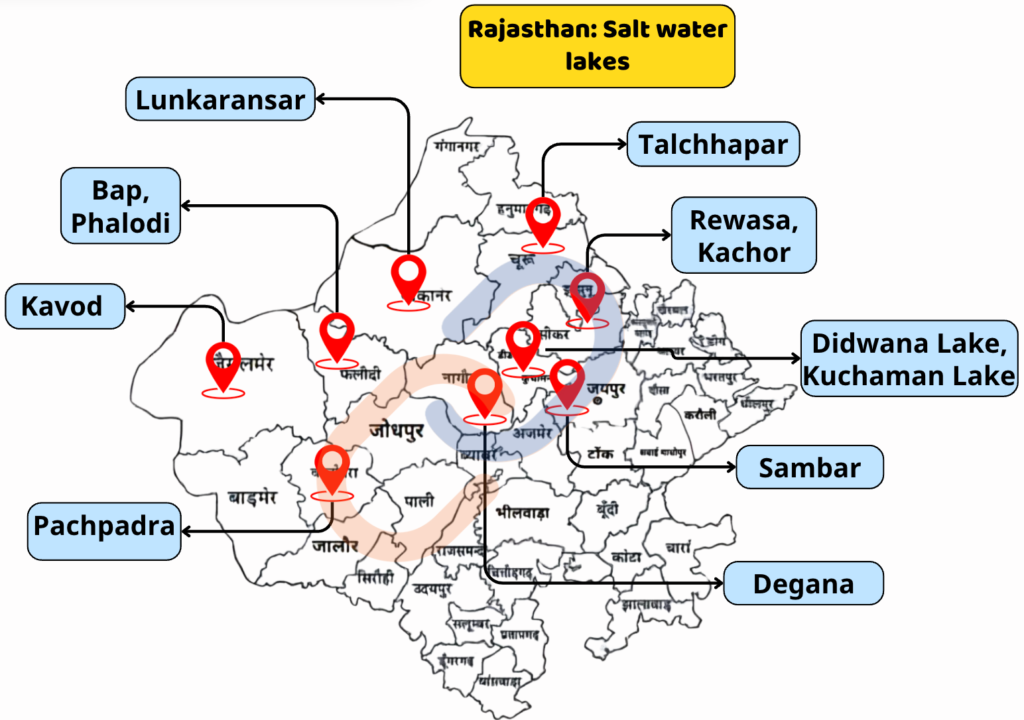This is Day 66 | 90 Days RAS Mains 2025 Answer Writing, We will cover the whole RAS Mains 2025 with this 90-day answer writing program
Click here for the complete 90 days schedule (English Medium)
Click here for complete 90 days schedule (Hindi Medium)
GS Answer Writing – Raj Geo: Broad Physical Features: Mountains, Plateaus, Plains, Deserts. | Major Rivers and Lakes | Climatic: Characteristics and their classification | Major Vegetation types | Agriculture- Major Crops: Production and Distribution। Elaboration
Rajasthan is known for salt water lakes.
- These lakes are found in the western desert and inter-territorial areas of the state.
- These lakes are natural and shallow.
- Salt is produced on a commercial scale in most of the lakes.
- Most of the salt water lakes in Rajasthan are found in Nagaur district.
Major lakes –
- Sambhar (Jaipur, Nagaur) is the largest salt water lake of Rajasthan. It was declared a Ramsar site in 1990. Mentha, Rupangarh, Khari, Khandela rivers fall into Sambhar.
- Pachpadra Lake – Located in Balotra (Barmer), excellent quality salt (98% sodium chloride) is produced here. Here the Kharwal caste uses Morli bush for salt production.
- The salt of Didwana Lake (Nagaur) is of low grade, hence it is used for industrial purposes instead of eating. Sodium sulphate plant has been installed here.
- Lunkaransar (Bikaner) and Kuchaman (Nagaur), Talchhapar (Churu), Phalodi (Jodhpur), Rewasa (Sikar), Kavod (Jaisalmer) etc. are other major brackish water lakes.

- Banas river is also known as Yamuna of Rajasthan, Van ki Asha or Varnasha.
- Originates from the Khamnor hills of Aravali.
- Flows from the Gogunda plateau southwards from Kumbhalgarh, crosses Nathdwara, Rajsamand Rail Magra, passes through Chittorgarh, Bhilwara, Tonk districts and meets Chambal in Sawai Madhopur.
- Banas is the longest flowing river in the state and the river with the largest catchment area.
- Bisalpur Dam has been built near Todaraisingh town on the banks of Banas River.
Tributaries – The main tributaries on the right side are Bedach, Menal and the main tributaries on the left side are Kothari, Khari, Morel, Dhund etc.
Forms three confluences or Triveni Sangam –
- Rameshwar (Sawai Madhopur): Chambal, Banas and Seep
- Menal (Bhilwara): Banas, Menal, Berach
- Rajmahal (Tonk): Banas, Khari, Dye
Despite its arid climate and sparse forest cover compared to other states, Rajasthan’s distinct physical and climatic conditions have led to diverse vegetation types thriving in different ecological niches. However, with only 9.60% forest cover compared to India’s 24.62%, the region faces significant challenges in maintaining its ecosystem balance.
- Tropical thorny/Xerophyte forest-
- 6% of Rajasthan area.
- 0-30 cms rainfall.
- Arid desert area.
- Jaisalmer, barmer, Bikaner, jodhpur.
- Thorny bushes, cactus, aloe vera.
- Prevents desertification.
- Tropical dhonk forest
- 58% of rajasthan area.
- 30-60cms rainfall
- Semi arid areas
- Shekhwati, nagour, luni basin, sawai madhopur, karauli.
- Khejri, rohida, babool, ber, ker
- Fuel wood supply.
- Tropical dry deciduous/Monsoon
- 28% of rajasthan area.
- 50-80cms rainfall
- Alwar, bharatpur, karauli, dholpur, Jaipur, tonk, dausa, Udaipur, Chittorgarh, Bhilwara, rajsamand
- Sal, teak, mango, rosewood,sandalwood,
- Timber of economic importance is supplied
- Tropical teak forest
- 7% of rajasthan area.
- 75-110 cms rainfall
- Banswara, Dungarpur, pratapgarh, kota, Jhalawar
- Mahua, gular, tendu, palash
- Industrial use
- Sub- tropical evergreen forest
- 1% of rajasthan area
- About 150cms rainfall
- Mountabu, sirohi
- Jamun, bamboo, ambartari(dicleptera abuensis)
- Highest biodiversity
Paper 4 (Comprehension part) – Elaboration
Justice delayed is justice denied
“Without Justice, life would not be possible, and even if it were, it would not be worth living”.
“Justice Delayed is Justice Denied” is a legal principle. Delay and unresolved questions have been the cause of controversy for the Indian judiciary for a long time. In the last five decades, the judiciary, leading experts, and legal advisors have established many schemes to address posting and adjudication problems in India.
Justice to all…the weak and the mighty, the rich and the poor…is the cornerstone of modern civilization. Justice to all is the quality of being impartial and prompt in dispensing justice. Delayed justice devalues the spirit of law. Timely justice upholds the honour & dignity of the aggrieved party and punishes those who violate the law. Delayed justice defeats the purpose of law while causing untold sufferings to those who need justice.
Justice done in time has a positive effect on other institutions of the society. If justice is delayed, the sufferings continue to pile on till the time justice is done. The fact is that delayed justice is no justice at all. Doing justice is one thing and doing it in time is another. Delayed justice amounts to dehumanizing the institutions of our society. The sooner justice is done, the better it is. Else justice loses its soul and essence.
As “justice delayed is justice denied,” they claim “justice hurried is justice buried” is equally valid. Therefore, the requisite condition of fair justice and balance of convenience is an appropriate, rational, and due hearing for all cases. Law is an outstanding achievement, which needs tremendous respect.
Day 66 | 90 Days RAS Mains 2025 Answer Writing
Day 66 | 90 Days RAS Mains 2025 Answer Writing

